10 animals that you will only find in the Galapagos
The Galapagos Islands is like no other place on the planet and its exclusive animals are no doubt one of its key defining elements. Located in a remote location about 1,000 km (600 miles) off the coast of Ecuador, the fauna was able to develop virtually unaffected by predators. In fact, the animals are so unthreatened by humans, that don’t be surprised if a sea lion’s flipper accidentally lands on you. The unique array of animal species ranging from giant tortoises to iguanas, to birds with different colored feet, provides for some up-close encounters not possible elsewhere.
Blue-footed booby
The Blue-footed Booby is a marine bird, which owes its signature blue feet thanks to sexual selection and carotonoid pigments obtained from its diet of fresh fish. You can find them on North Seymour, as well as on some of the Southern islands like Isabela and Floreana. See them in flight while on a panga, perching on the cliffs, or while on a guided walk on one of the aforementioned islands.
 Darwin’s finch
There are 13 endemic species of these fascinating creatures, each with a unique beak adapted to every island’s singular habitat. They can be seen on most of the main islands on land visits, so make sure to bring binoculars or a good camera with a zoom lens to spot them.
Darwin’s finch
There are 13 endemic species of these fascinating creatures, each with a unique beak adapted to every island’s singular habitat. They can be seen on most of the main islands on land visits, so make sure to bring binoculars or a good camera with a zoom lens to spot them.
 Galapagos green sea turtle
The Galapagos Green Sea Turtles live in the tropical and subtropical waters of the Pacific Coast and can be seen in coastal waters throughout the archipelago. You can frequently spot them while snorkeling and on a panga ride.
Galapagos green sea turtle
The Galapagos Green Sea Turtles live in the tropical and subtropical waters of the Pacific Coast and can be seen in coastal waters throughout the archipelago. You can frequently spot them while snorkeling and on a panga ride.
 The Galapagos penguin
Contrary to popular belief there is a penguin that lives north of the equator and this friendly creature is found only in the Galapagos. The Galapagos penguin is endemic to the islands, able to survive there thanks to the cold waters from the Humboldt and Cromwell Currents. You can spot them while kayaking, snorkeling or panga riding during your Galapagos cruise.
The Galapagos penguin
Contrary to popular belief there is a penguin that lives north of the equator and this friendly creature is found only in the Galapagos. The Galapagos penguin is endemic to the islands, able to survive there thanks to the cold waters from the Humboldt and Cromwell Currents. You can spot them while kayaking, snorkeling or panga riding during your Galapagos cruise.
 Galapagos sea lion
The Galapagos Sea Lion primarily breeds on the Galapagos Islands, and are one of the two types of seals found on the Islands. You can find them widespread along the coastline while snorkeling or on a land visit walking along the shore while they rest on the beach.
Galapagos sea lion
The Galapagos Sea Lion primarily breeds on the Galapagos Islands, and are one of the two types of seals found on the Islands. You can find them widespread along the coastline while snorkeling or on a land visit walking along the shore while they rest on the beach.
 The Galapagos giant tortoise
Giant Tortoises are one of the most quintessential animals of the Galapagos, and there are only ten different species remaining of the original fifteen. These giant creatures can weigh up to 417 kg and can live in the wild for over 100 years. You can spot them in the wild in the Highlands of Santa Cruz, so make sure that your cruise includes this visit if you are looking forward to see them.
The Galapagos giant tortoise
Giant Tortoises are one of the most quintessential animals of the Galapagos, and there are only ten different species remaining of the original fifteen. These giant creatures can weigh up to 417 kg and can live in the wild for over 100 years. You can spot them in the wild in the Highlands of Santa Cruz, so make sure that your cruise includes this visit if you are looking forward to see them.
 Lava Lizard
Six of the existing species of lava lizards are endemic to the Galapagos Islands, and they are some of the most abundant reptiles found in the Galapagos. You can witness these creatures doing pushups on a land visit to any of the islands from your cruise.
Lava Lizard
Six of the existing species of lava lizards are endemic to the Galapagos Islands, and they are some of the most abundant reptiles found in the Galapagos. You can witness these creatures doing pushups on a land visit to any of the islands from your cruise.
 Marine iguana
Marine Iguanas are the only reptile species that have the ability to forage for food in the sea, which makes it a marine reptile. They mainly live in colonies on rocky shores, but can also be seen in marshes, mangroves and beaches throughout the Galapagos Islands. You can see them while Kayaking in Santa Cruz or lying on the rocks near the Charles Darwin Station, as well as on many of the rockier surfaces in the archipelago while they sunbathe.
Marine iguana
Marine Iguanas are the only reptile species that have the ability to forage for food in the sea, which makes it a marine reptile. They mainly live in colonies on rocky shores, but can also be seen in marshes, mangroves and beaches throughout the Galapagos Islands. You can see them while Kayaking in Santa Cruz or lying on the rocks near the Charles Darwin Station, as well as on many of the rockier surfaces in the archipelago while they sunbathe.
 Sally Lightfoot crab
The main function of these brightly colored sea scavengers is to keep the shore clean of any organic debris and eat ticks off marine iguanas. They can be seen feeding in large groups on most beaches and in shallow water all around the Islands. You can see them from the panga, or on the rocks while snorkeling, swimming or walking along the shore.
Sally Lightfoot crab
The main function of these brightly colored sea scavengers is to keep the shore clean of any organic debris and eat ticks off marine iguanas. They can be seen feeding in large groups on most beaches and in shallow water all around the Islands. You can see them from the panga, or on the rocks while snorkeling, swimming or walking along the shore.
 Waved albatross
The Waved Albatross, the largest bird in the islands, breeds primarily on Española Island. If you want to be sure to see the Waved Albatross during your stay in the Galapagos, make sure to book a cruise that includes Española in its itinerary from April and December when they breed on the ground.
Waved albatross
The Waved Albatross, the largest bird in the islands, breeds primarily on Española Island. If you want to be sure to see the Waved Albatross during your stay in the Galapagos, make sure to book a cruise that includes Española in its itinerary from April and December when they breed on the ground.
 Carlos Beate is the Commercial Manager at Andando Tours. Andando Tours offers exclusive traveling experiences, specializing in sailing around the Galapagos Islands and overland along the magnificent Avenue of Volcanoes on the Ecuadorian Andes.
If you would like to be a guest blogger on A Luxury Travel Blog in order to raise your profile, please contact us.
Carlos Beate is the Commercial Manager at Andando Tours. Andando Tours offers exclusive traveling experiences, specializing in sailing around the Galapagos Islands and overland along the magnificent Avenue of Volcanoes on the Ecuadorian Andes.
If you would like to be a guest blogger on A Luxury Travel Blog in order to raise your profile, please contact us.
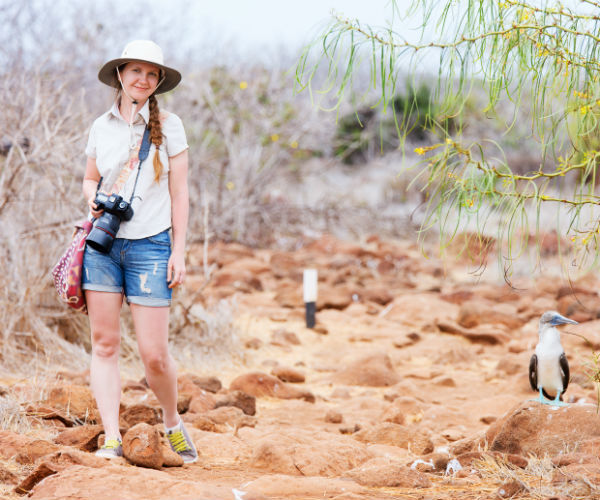 Darwin’s finch
There are 13 endemic species of these fascinating creatures, each with a unique beak adapted to every island’s singular habitat. They can be seen on most of the main islands on land visits, so make sure to bring binoculars or a good camera with a zoom lens to spot them.
Darwin’s finch
There are 13 endemic species of these fascinating creatures, each with a unique beak adapted to every island’s singular habitat. They can be seen on most of the main islands on land visits, so make sure to bring binoculars or a good camera with a zoom lens to spot them.
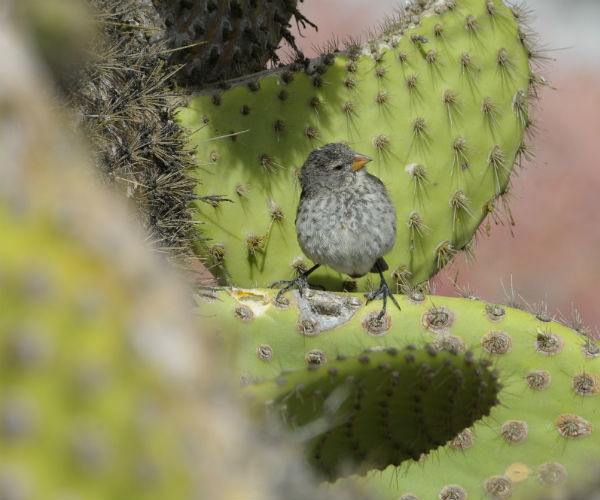 Galapagos green sea turtle
The Galapagos Green Sea Turtles live in the tropical and subtropical waters of the Pacific Coast and can be seen in coastal waters throughout the archipelago. You can frequently spot them while snorkeling and on a panga ride.
Galapagos green sea turtle
The Galapagos Green Sea Turtles live in the tropical and subtropical waters of the Pacific Coast and can be seen in coastal waters throughout the archipelago. You can frequently spot them while snorkeling and on a panga ride.
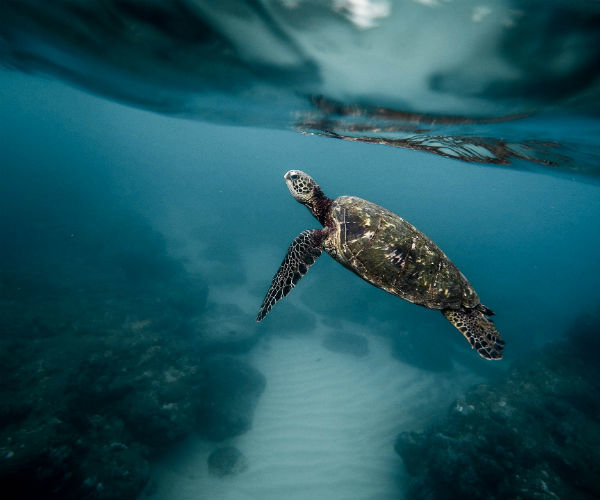 The Galapagos penguin
Contrary to popular belief there is a penguin that lives north of the equator and this friendly creature is found only in the Galapagos. The Galapagos penguin is endemic to the islands, able to survive there thanks to the cold waters from the Humboldt and Cromwell Currents. You can spot them while kayaking, snorkeling or panga riding during your Galapagos cruise.
The Galapagos penguin
Contrary to popular belief there is a penguin that lives north of the equator and this friendly creature is found only in the Galapagos. The Galapagos penguin is endemic to the islands, able to survive there thanks to the cold waters from the Humboldt and Cromwell Currents. You can spot them while kayaking, snorkeling or panga riding during your Galapagos cruise.
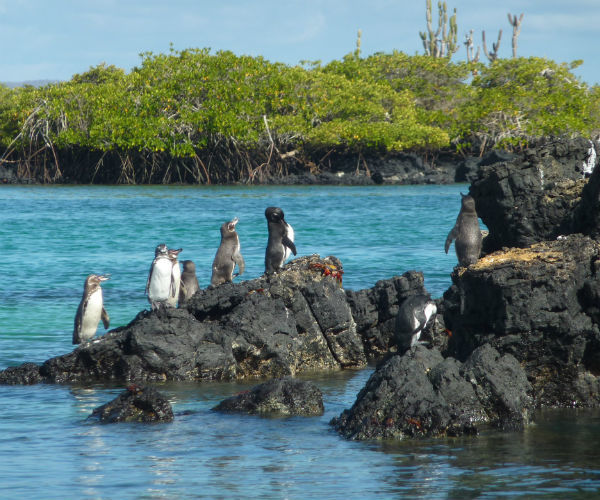 Galapagos sea lion
The Galapagos Sea Lion primarily breeds on the Galapagos Islands, and are one of the two types of seals found on the Islands. You can find them widespread along the coastline while snorkeling or on a land visit walking along the shore while they rest on the beach.
Galapagos sea lion
The Galapagos Sea Lion primarily breeds on the Galapagos Islands, and are one of the two types of seals found on the Islands. You can find them widespread along the coastline while snorkeling or on a land visit walking along the shore while they rest on the beach.
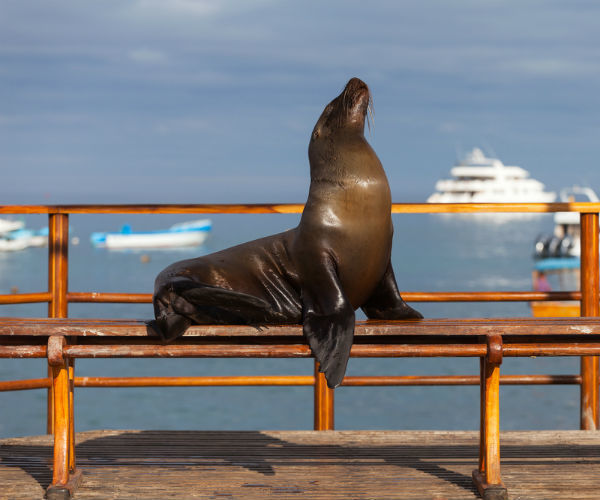 The Galapagos giant tortoise
Giant Tortoises are one of the most quintessential animals of the Galapagos, and there are only ten different species remaining of the original fifteen. These giant creatures can weigh up to 417 kg and can live in the wild for over 100 years. You can spot them in the wild in the Highlands of Santa Cruz, so make sure that your cruise includes this visit if you are looking forward to see them.
The Galapagos giant tortoise
Giant Tortoises are one of the most quintessential animals of the Galapagos, and there are only ten different species remaining of the original fifteen. These giant creatures can weigh up to 417 kg and can live in the wild for over 100 years. You can spot them in the wild in the Highlands of Santa Cruz, so make sure that your cruise includes this visit if you are looking forward to see them.
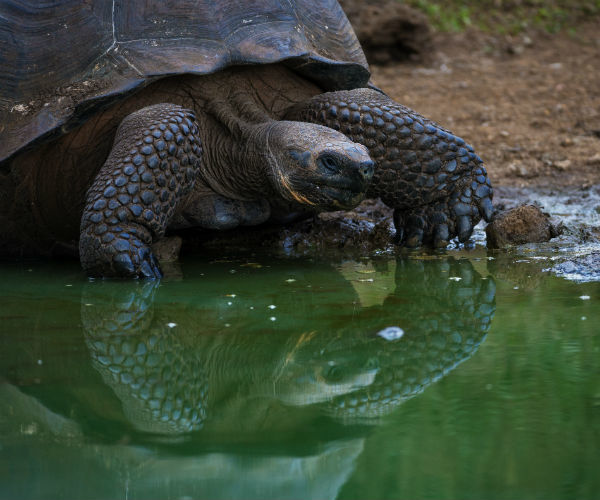 Lava Lizard
Six of the existing species of lava lizards are endemic to the Galapagos Islands, and they are some of the most abundant reptiles found in the Galapagos. You can witness these creatures doing pushups on a land visit to any of the islands from your cruise.
Lava Lizard
Six of the existing species of lava lizards are endemic to the Galapagos Islands, and they are some of the most abundant reptiles found in the Galapagos. You can witness these creatures doing pushups on a land visit to any of the islands from your cruise.
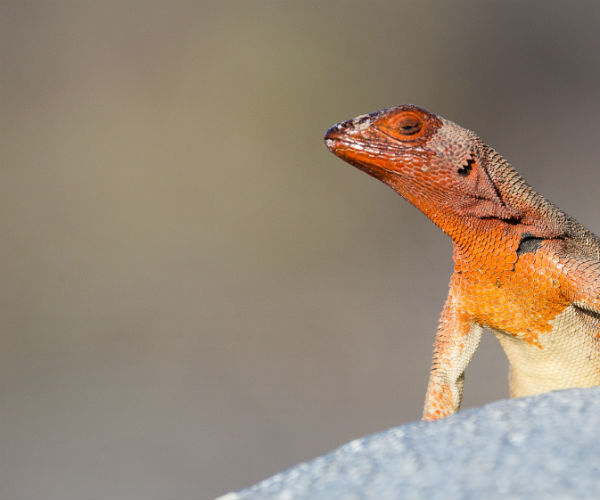 Marine iguana
Marine Iguanas are the only reptile species that have the ability to forage for food in the sea, which makes it a marine reptile. They mainly live in colonies on rocky shores, but can also be seen in marshes, mangroves and beaches throughout the Galapagos Islands. You can see them while Kayaking in Santa Cruz or lying on the rocks near the Charles Darwin Station, as well as on many of the rockier surfaces in the archipelago while they sunbathe.
Marine iguana
Marine Iguanas are the only reptile species that have the ability to forage for food in the sea, which makes it a marine reptile. They mainly live in colonies on rocky shores, but can also be seen in marshes, mangroves and beaches throughout the Galapagos Islands. You can see them while Kayaking in Santa Cruz or lying on the rocks near the Charles Darwin Station, as well as on many of the rockier surfaces in the archipelago while they sunbathe.
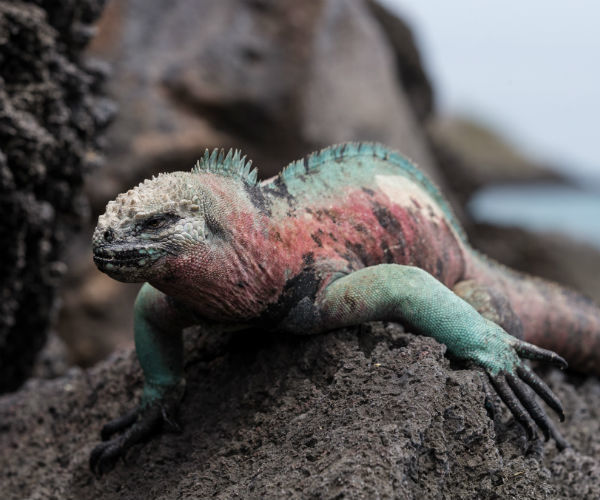 Sally Lightfoot crab
The main function of these brightly colored sea scavengers is to keep the shore clean of any organic debris and eat ticks off marine iguanas. They can be seen feeding in large groups on most beaches and in shallow water all around the Islands. You can see them from the panga, or on the rocks while snorkeling, swimming or walking along the shore.
Sally Lightfoot crab
The main function of these brightly colored sea scavengers is to keep the shore clean of any organic debris and eat ticks off marine iguanas. They can be seen feeding in large groups on most beaches and in shallow water all around the Islands. You can see them from the panga, or on the rocks while snorkeling, swimming or walking along the shore.
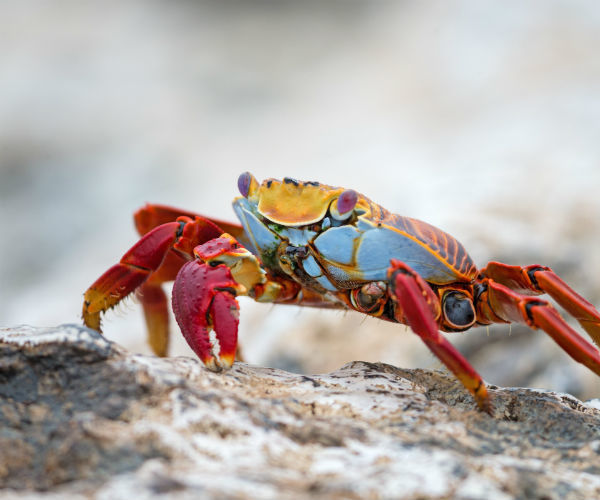 Waved albatross
The Waved Albatross, the largest bird in the islands, breeds primarily on Española Island. If you want to be sure to see the Waved Albatross during your stay in the Galapagos, make sure to book a cruise that includes Española in its itinerary from April and December when they breed on the ground.
Waved albatross
The Waved Albatross, the largest bird in the islands, breeds primarily on Española Island. If you want to be sure to see the Waved Albatross during your stay in the Galapagos, make sure to book a cruise that includes Española in its itinerary from April and December when they breed on the ground.
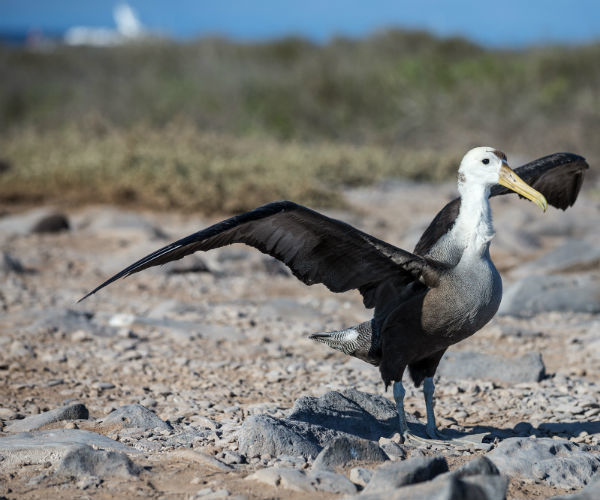 Carlos Beate is the Commercial Manager at Andando Tours. Andando Tours offers exclusive traveling experiences, specializing in sailing around the Galapagos Islands and overland along the magnificent Avenue of Volcanoes on the Ecuadorian Andes.
If you would like to be a guest blogger on A Luxury Travel Blog in order to raise your profile, please contact us.
Carlos Beate is the Commercial Manager at Andando Tours. Andando Tours offers exclusive traveling experiences, specializing in sailing around the Galapagos Islands and overland along the magnificent Avenue of Volcanoes on the Ecuadorian Andes.
If you would like to be a guest blogger on A Luxury Travel Blog in order to raise your profile, please contact us.Did you enjoy this article?
Receive similar content direct to your inbox.


Looks as if the Sally Lightfoot Crab is in party mode, about to hit town for a night out. He obviously doesn’t do cautious camouflage! Looks as if he’s wearing his brightest beach shirt.
They are so bright! And you can easily spot them during your time in the beach
The more I see of the Galapagos – and these are amazing pictures – the more I get inspired to go there. Everyday must be like being in the middle of a David Attenborough documentary.
Well you should start packing :)
It actually is, everyday on your cruise is like walking on a living experiment alongside with your guide (your guide will be like your personal David Attenborough)
If you do a trip to the Galapagos you’ll probably find that it’s not just the wildlife that is interesting. When I went on a cruise we had one guy who was a marine biologist and he knew so much and was willing to share it too. Then there was another guy, not in the same league of expertise as the marine biologist, who was an enthusiastic bird watcher. He could tell you what species a bird was from about a mile away.
Wow! You are a lucky man. Learning in the Galapagos is a fascinating experience.
You know your level of immaturity when you read ‘Blue-footed booby’ and still can’t help but laugh! Having never been to the Galapagos I’ve never seen any of these, but there are a few I’ve never even heard of either. There are some truly remarkable creatures. I like that many are confident and not threatened by humans. That’s the way it should be. I’ve seen penguins before and yet any time I see them I’m always just as amazed as the first time. So sweet. I wonder how the Galapagos penguin differs to others? And the Darwin finch is just so precious.
Well, imagine going on a cruise and your guide telling you: Oh, look a booby! Well the Galapagos penguin differ from others mainly because is the only penguin that lives north of the equator. Additionally they breed year round and the incubation process takes longer than a month and they are the smallest type of penguin. Unfortunately the Galapagos penguin is listed as endangered due to climate variability and invasive species.
How could all the animals in Galapagos be this colorful, when they are all just gray on my side of the world? Amazing how animals really evolve and adapt to their environment. This also goes to show you that keeping a place pristine and low-key allows for animals to thrive and evolve. That blue-footed booby is beautiful. I haven’t seen one close to it. I hope the Galapagos can continue to be a refuge for these special creatures.
They animals in the Galapagos are everything! But I am curious about where you live now!
Definitely keeping ecosystems protected from any possible harm is the best way to protect the wildlife. Hopefully every country will follow that path in the future.